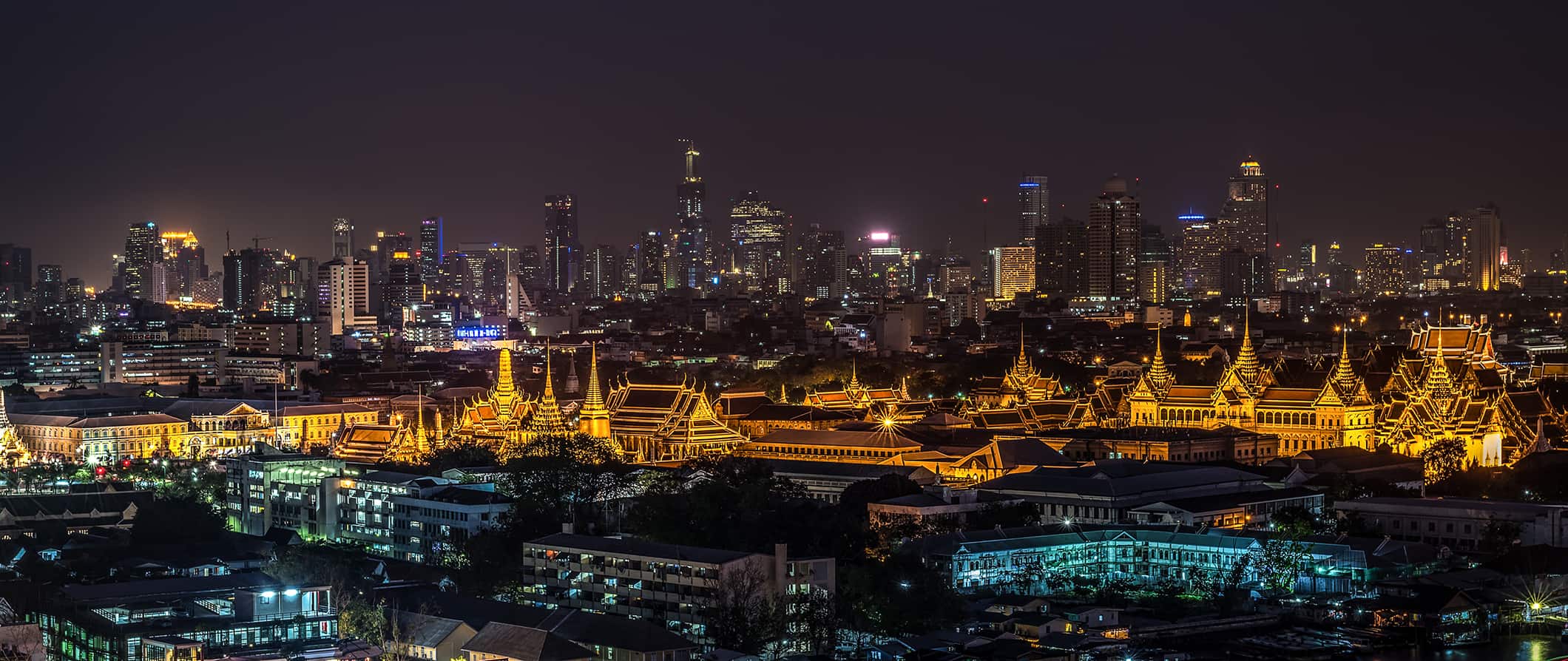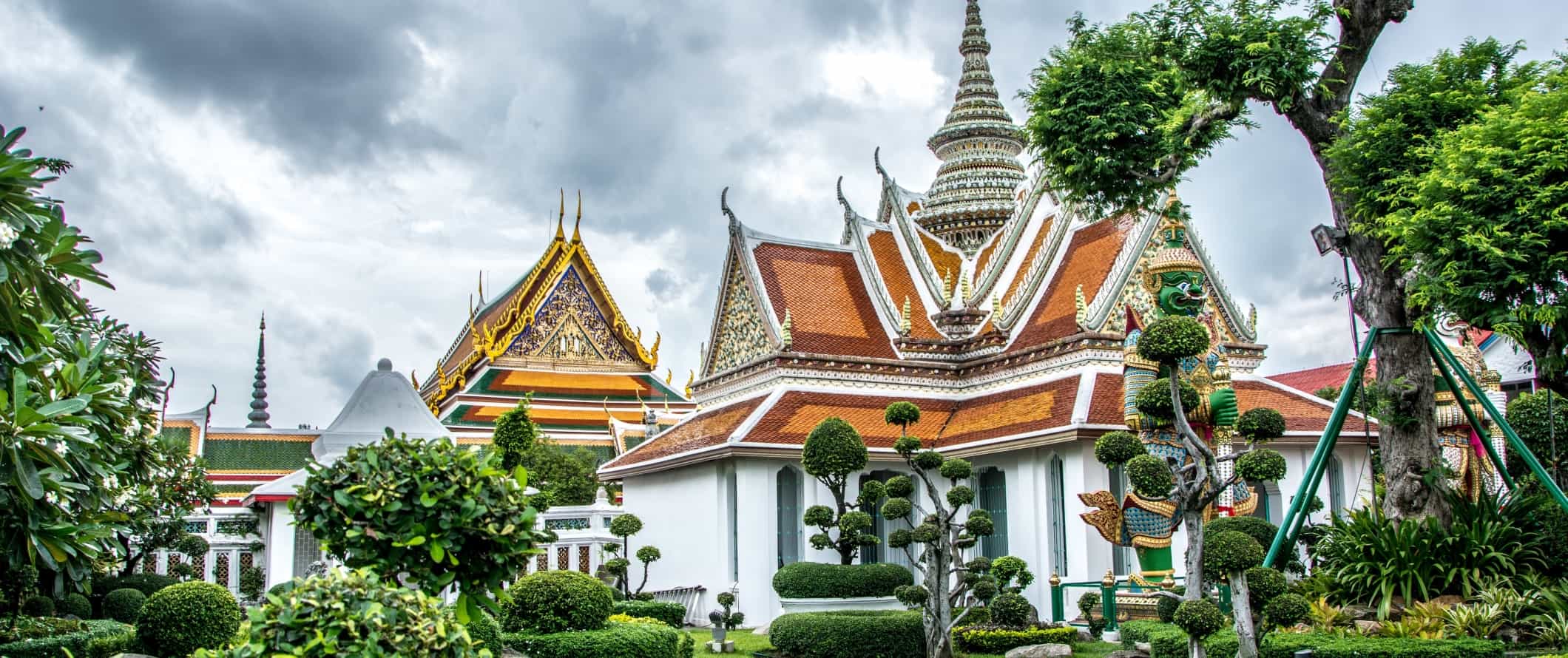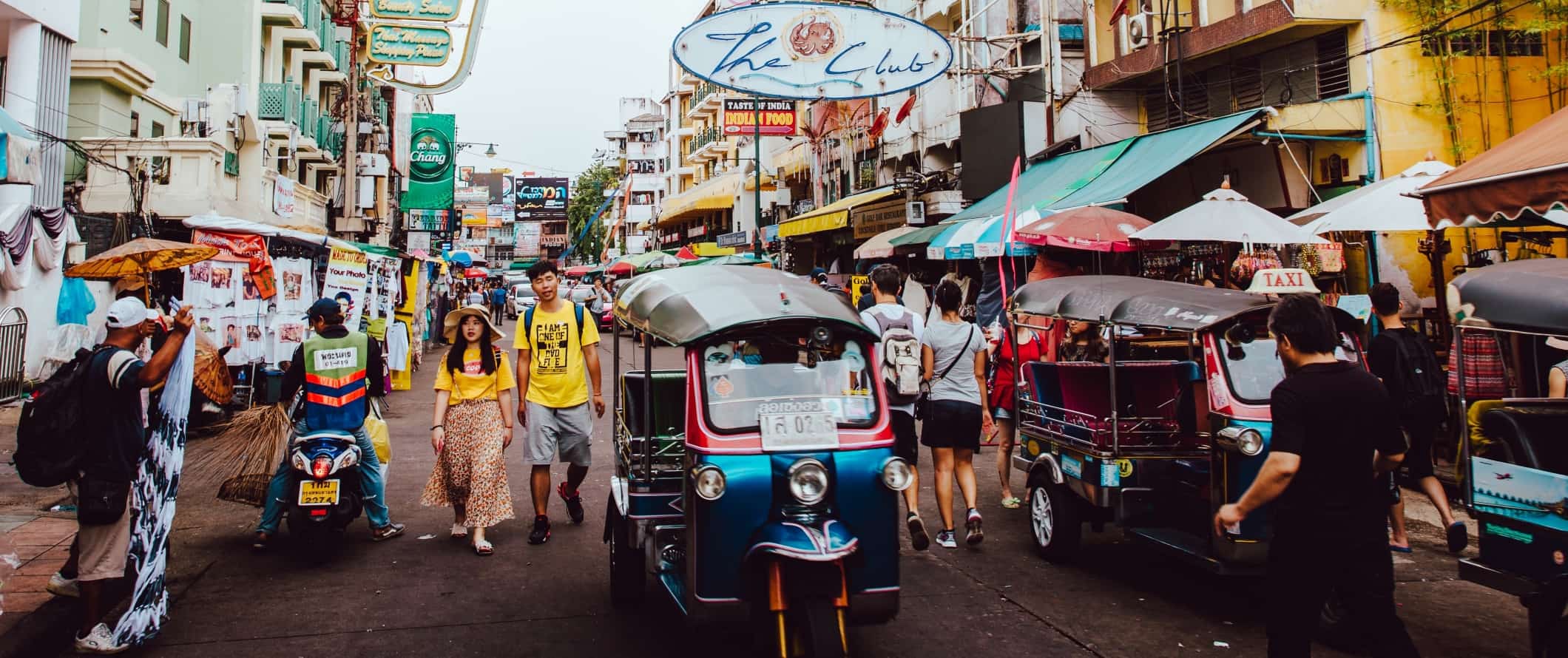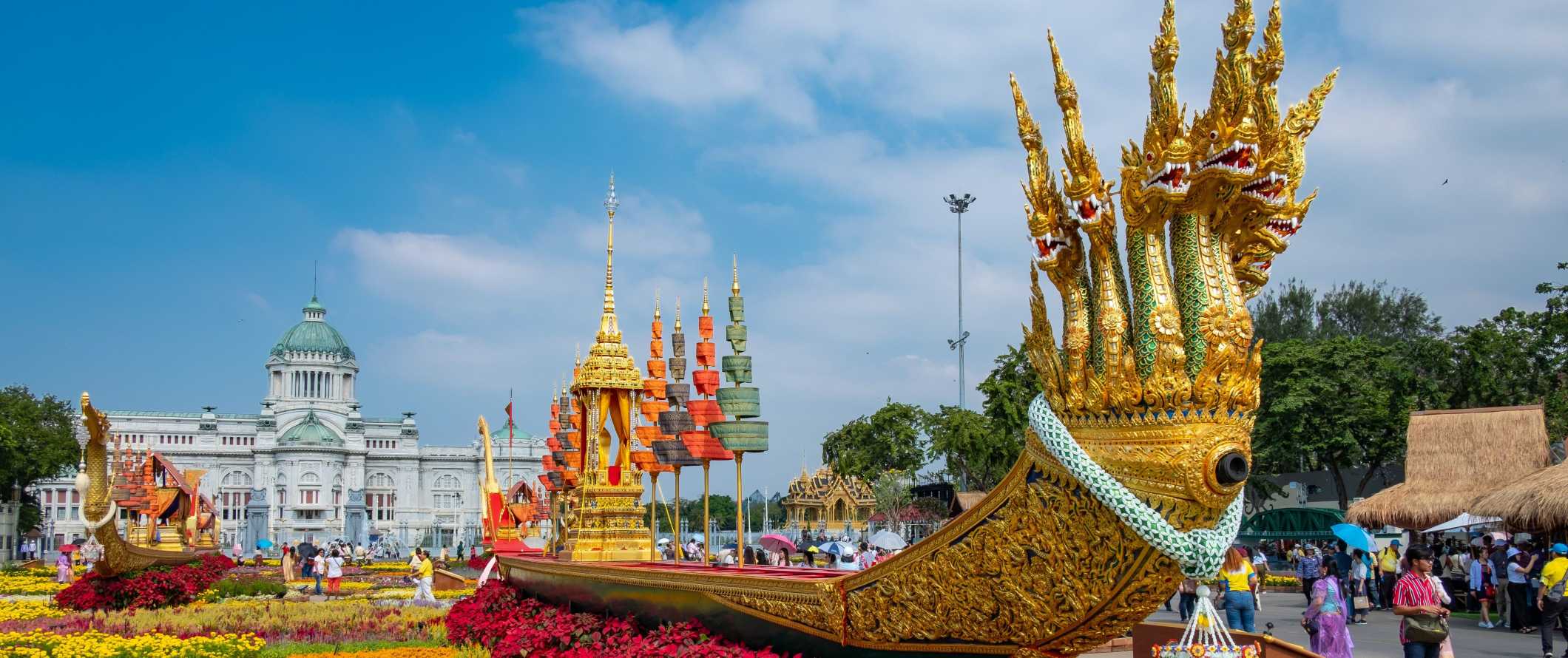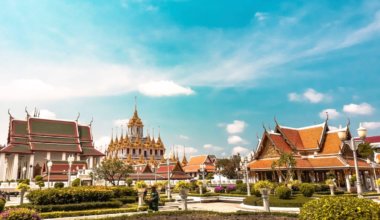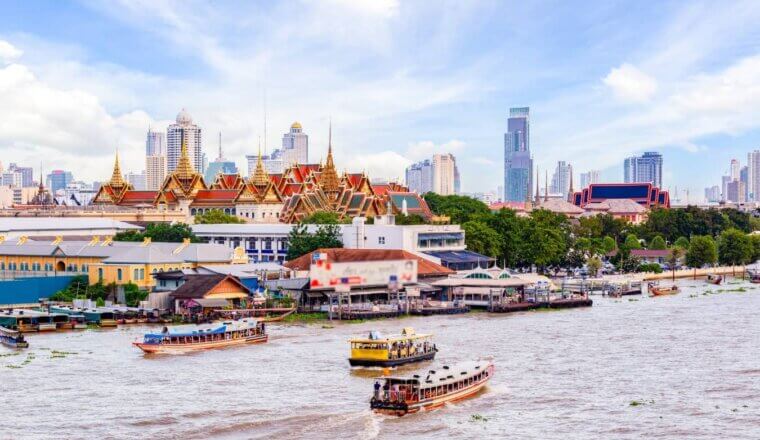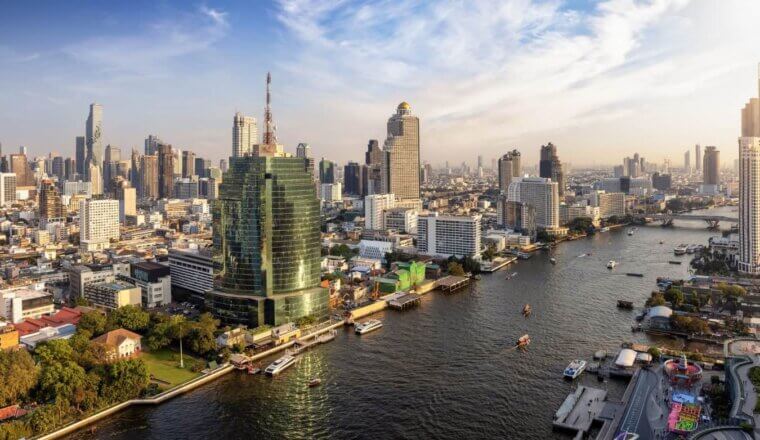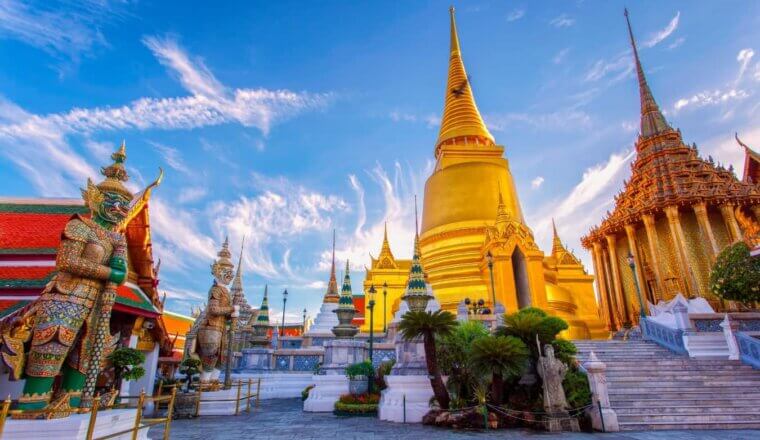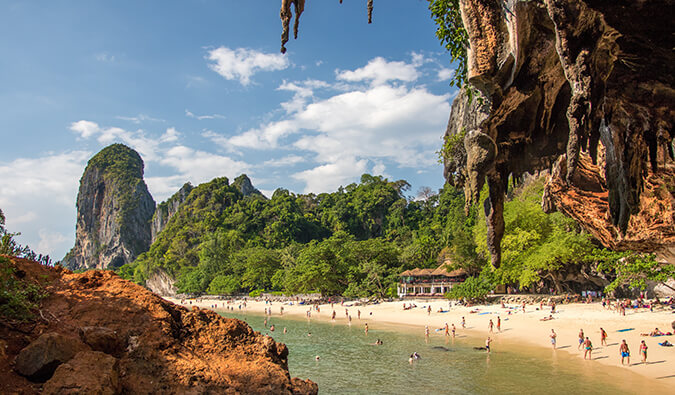Bangkok is famous for its chaotic streets, cheap and delicious street food, wild nightlife, and never-ending traffic. But it’s also a city that most travelers either love or hate.
Personally, I hated it when I first arrived. But, when I got to know it more, I changed my mind. Then, when I moved to Bangkok in 2006, I fell madly in love with it.
Most travelers just pass through here when they backpack or travel around Thailand. But there’s a lot to see and do in Bangkok. It’s worth a few days at the least. Because when you look beyond the chaos and peel back Bangkok’s layers, the city comes alive with endless things to do, see, explore, eat, and drink. It’s a city that opens itself up to those who are willing to get past all the temples and backpacker bars.
You just need to know where to look.
This Bangkok travel guide shows you there’s more to Thailand’s “City of Angels” than you think, with tips on how to plan, save money, and make the most of your visit to this hectic and vibrant capital!
Table of Contents
Top 5 Things to See and Do in Bangkok
1. Visit the Grand Palace and Wat Pho
The palace is the official residence of the current monarch. Check out Wat Pra Kaeo, which houses the 15th century Emerald Buddha, tons of temples, statues, and beautiful artwork. Afterward, head to Wat Pho to see the famous golden reclining Buddha. It costs 500 THB to enter the Grand Palace and 200 THB to enter Wat Pho.
2. Tour the Chatuchak Weekend Market
Bangkok’s weekend market, the largest such market in the world, is an ideal place to buy anything and everything. It has over 15,000 stalls, making it the best place to get gifts, find knockoffs, barter, and eat some good food. It’s open on Saturday and Sunday, 9am-6pm.
3. Explore Lumpini Park
Outdoor enthusiasts will find it hard to tear themselves away from Bangkok’s Lumpini Park. Jogging paths, bicycle paths, picnic areas, chess tables, Tai Chi classes, fitness equipment, and rowboats for rent on the lakes offer plenty to do. The tall trees and quiet setting offer a nice reprieve from busy Bangkok.
4. See Jim Thompson’s House
Jim Thompson was an American spy and silk merchant in Thailand during the 1950s and 1960s. His house is a monument to traditional Thai architecture, decorated with beautiful teak wood and enveloped by a lush garden. The entrance fee is 200 THB and it’s open daily from 10am-6pm.
5. Take in the view from Wat Arun
This is a gorgeous Buddhist temple on the Chao Phraya River opposite the Grand Palace. It has one main spire and four small ones and is so iconic that it’s on Thai money. From the top of the main spire, you get to see sweeping views of the city. Admission is 100 THB.
Other Things to See and Do in Bangkok
1. Visit the Damnoen Saduak Floating Market
This floating market is just outside of Bangkok. While it exists mostly for the benefit of tourists, I still like visiting. The tours that come here are about half a day and leave early in the morning. It’s not a great place to shop, but the area is good for photography and eating. Open 7am-3pm daily.
2. Temple hop
Bangkok is full of history, temples, and Thai ruins. There are around ten main temples in the city, all with different architectural structures and layouts. You can easily hire someone to take you to all of them in one day, as it only takes a few hours to see them all. If you don’t have that much time, aside from the Grand Palace and Wat Po, make sure you check out Wat Arun, The Temple of the Dawn. Just be sure to dress appropriately, keeping your legs and shoulders covered, as these are functioning temples.
3. Shop ’til you drop
Bangkok has tons of shopping centers (they’re super popular here and sell everything). Make sure you check out Siam Paragon (for designer clothes), Terminal 21 (to see the stunning internationally themed decor), Platinum (for cheap, trendy clothes), Pantip (for cheap electronics), and MBK (for cheap knockoffs).
4. Hang out on Khao San Road
Khao San Road is the infamous backpacker/tourist street in Bangkok. All travel roads lead in and out of here. However, it is more than just a transit hub for travelers, offering a fun nightlife, delicious food, plenty of shopping stalls, tons of people watching, and bustling activity day and night. It’s much more commercial than it used to be, but it’s still fun to explore! Here’s a video.
5. Visit the Temple of the Golden Mount
Only a short distance from Khao San Road, The Temple of the Golden Mount (Wat Saket) features an enormous chedi, a mound-like structure containing Buddhist relics. This is one of my favorite temples in the city because of its beautiful golden temple, stunning setting, and wonderful views of the city from the top. At the base of the mountain is an overgrown cemetery for 18th-century plague victims. Entry to the temple itself is free but it costs 50 THB to go to the chedi.
6. Day trip to Ayutthaya
Close to Bangkok is the old capital of the Kingdom of Siam. This historic city, now a UNESCO World Heritage Site, is home to the summer palace and tons of breathtaking and unique temples. Since it is so close to Bangkok, it’s a very popular day-trip destination for tours. Lots of companies offer trips but it’s so easy to get to that I would simply go on your own by train. Train tickets cost 90-130 THB round-trip, with the journey taking 1.5 hours each way. You can visit on a day trip with Get Your Guide for just 900 THB.
7. Enjoy Bangkok’s famous nightlife scene
You’ll never have a problem finding good bars and clubs to go to in Bangkok. Khao San Road and Silom are two of the most popular nightlife spots in the city and some of my favorite bars are Brick Bar (a huge space with live ska & reggae music), Smalls (speakeasy cocktail bar), and Whisgars (cigar lounge and whiskey bar).
8. Eat in Chinatown
First, wander among the lilies, birds of paradise, and orchids at Pak Klong Talad, the flower market at the north end of Chinatown. From there, grab a bite to eat at one of the many food stalls. You can eat your weight in street food here and still not break the bank. It’s one of the best and cheapest places to eat in the city!
9. Watch a puppet show
A huge part of traditional Thai culture revolves around puppetry. Two types are common – Nang (shadow puppets) and Hun (marionettes). If you’re lucky, you can see a show at an outdoor festival. Otherwise, head to the Joe Louis Traditional Thai Puppet Theatre, founded in 1985 by Sakorn Yang-keawsot (whose English name was Joe Louis), where tickets cost around 700 THB for a performance.
10. Spend a hip night out in Thong Lo
The city’s top-end dining and nightlife lies in this trendy neighborhood, including many Western jazz bars and beer gardens. It’s very popular with Bangkok’s young middle and upper classes. The neighborhood is very walkable and a great place for a fashionable night out. Popular spots include Beer Belly, a craft beer bar with beer pong and a 2-for-1 happy hour from 5-8 pm; and Rabbit Hole, a swanky bar with creative cocktails.
11. Boat down the Bangkok canals
Known as the “Venice of the East,” Bangkok used to be full of waterways and canals. While not as many of those exist anymore, you can still see many of the old bridges and stilt houses, and colorful flower gardens crowding the waterways. You can cruise along the Chao Phraya River to see what remains. Thai Canal Tours offers various group and private canal tours, starting at 2,200 THB a full-day tour, including lunch.
12. Wander the Rot Fai Night Market
Rot Fai Market (or Train Market) is an authentic open-air bazaar selling an array of vintage collectibles and memorabilia, from antique furniture to hippy fashion and Mao kitsch. The Train Night Market is absolutely one of the coolest markets in Bangkok. It’s open at night Thursday through Sunday.
13. See a Muay Thai fight
If you want to see a Muay Thai fight in the city, Lumpinee Stadium is the place to go. While Lumpinee has been hosting Muay Thai fights since the 1950s, the new stadium (which opened in 2014) is huge and can hold up to 15,000 spectators. Fight nights are Tuesday, Friday, and Saturday at 6pm and tickets start at 1,600 THB (buy them online directly from the stadium website for the best price).
14. See Wat Suthat & the Giant Swing
Famous for the Giant Swing that meets you at the entrance of the temple, Wat Suthat is one of Bangkok’s most memorable tourist sites. The Giant Swing was first constructed in 1784 but was replaced in 2005 with an entirely golden teak one (the temple was added in 1807). Aside from the swing, the temple features a magnificent traditional roof, ancient murals, and hand-carved teak door panels. The huge complex includes multiple large temples on the property as well as smaller statues and courtyards. Entrance is 20 THB and it’s open daily from 9am-6pm.
15. Tour the Bangkok Butterfly Garden & Insectarium
This small garden is located around the corner from the Chatuchak Weekend Market. There are over 500 butterflies flying around this domed enclosure, which also features a wide range of flowers, ferns, and even some waterfalls. Entry is free and it’s open Tuesday-Sunday. The butterfly garden is located next to three sprawling parks to continue your day in nature: Queen Sirikit Gardens, Rod Fai Park, and Chatuchak Park. It’s the perfect area to relax and take a stroll.
16. Visit the Bangkokian Museum
This folk museum depicts middle-class life in Bangkok during the 1950s with a collection of three wooden houses filled with family items from that period (the building is from that era as well). It’s small, so you don’t need a lot of time. It’s also free and includes a guided tour.
17. Peruse the National Gallery
This portrait museum has some amazing portraits of the royal family as well as paintings done by the late king, who was an artist and musician in his spare time. It’s located in the former Royal Mint building, they have excellent interim contemporary art exhibits from local artists on the ground floor. Admission is 200 THB.
18. Take a food tour
Bangkok has an incredible food scene and is one of the best foodie destinations in the world. The best way to learn about the food culture (while devouring some samples) is on a food tour. Bangkok Food Tours has a variety of tasty tours where you can try everything from street food to exotic fruits. Tours start from 1,450 THB. And for cooking classes, a half-day cooking class (including a market visit) costs around 1,300 THB.
For more information on other cities and islands in Thailand, check out the guides below:
Bangkok Travel Costs
Hostel prices – Dorm rooms with 6-8 beds start around 170-220 THB per night on Khao San Road, where accommodation is cheapest. A bed in a 4-6-bed dorm in more upscale hostels (with air conditioning) costs around 300-500 THB.
Private rooms are popular and vary in price, but generally cost around 700-900 THB. Although there’s a growing hostel scene downtown, I find the rooms expensive – especially when you can get cheaper accommodation and meet more travelers on Khao San Road.
Free Wi-Fi is standard, as are free linens and air conditioning, though free breakfast is not. Most hostels in Bangkok often have a range of additional fun amenities, such as swimming pools, outdoor terraces, and free bikes rentals. Most also have a bar or café on-site as well but shared kitchen facilities are not common.
Note that many hostels only accept cash.
Budget hotel prices – Private rooms in small guesthouses or hotels (especially those in the backpacker area of Khao San Road) start at 400-600 THB for a double room with a private bathroom. If you want something cheaper, you can find single rooms in other areas from 220 THB (fan, shared bathroom), and double rooms from 320 THB (fan, shared bathroom).
If you want a decent hotel room, however, expect to pay around 900 THB for a double with a private bathroom.
Quality varies greatly so be sure to look at the reviews online. Most hotels offer free Wi-Fi and air-conditioning and many offer free breakfast as well.
As for Airbnb, you can find full apartments for rent averaging around 850-1,200 THB while private rooms start around 480 THB per night.
Average cost of food – Thai cuisine uses many ingredients to create layers of flavor. Typical spices and herbs include garlic, basil, galangal, cilantro, lemongrass, kaffir lime leaves, chilies, and fish sauce. Thailand’s neighboring countries all influence the country’s flavorful cuisine which is aromatic and spicy with a variety of curries, salads, soups, and stir-fries that differ based on region.
Rice and noodles are central to Thai food, while the most popular meats are pork, chicken, fish, and seafood. Popular dishes include tom yum goong (hot and sour soup with shrimp), massaman curry, som tam (spicy papaya salad), kao phad (fried rice), khao man gai (rice with boiled chicken), and satay (grilled meat on skewers, served with a peanut dipping sauce).
Pat tai(more commonly known to Westerners as pad thai) is undoubtedly Bangkok’s most famous dish. This stir fry noodle dish usually contains fresh shrimp, bean sprouts, tofu, egg, and is served with lime wedges.
In Bangkok, you can eat from the street vendors for as little as 30-45 THB per meal, purchase a bag of freshly cut fruit or Thai iced tea for 20 THB, or get a grilled chicken, rice, and som tam meal for 150 THB. For the best pad thai in the city, go-to Pad Thai Thip Samai, where you can get a very filling dish for 75 THB.
Seafood, even from street vendors, is more expensive. Expect to pay 200-400 THB for a seafood dish. Sit down Thai restaurants begin at 65 THB per meal. Try Aisa Rot Dee, which is tucked away on Tanee Road.
Western food begins at around 150 THB and increases from there. A pizza is 250 THB, a pasta dish is 320-400 THB, and a burger is around 250-300 THB. If you’re eating downtown, expect a Western breakfast or lunch to cost between 200-350 THB. A Western fast food combo meal (think McDonald’s) costs around 200 THB.
Many of the malls have huge (and popular) food courts where you can get a filling meal for around 60-100 THB. Like the rest of Thailand, if you eat at the street markets like the locals, you’ll be hard-pressed to break the bank.
When it comes to drinking, going to bars can become pricey. The cheapest beers cost about 60-85 THB each, a glass of wine costs 120 THB, and cocktails cost around 370-420 THB. You can save money by buying beers from 7-Eleven.
For non-alcoholic drinks, a latte is around 65 THB and soda is around 25 THB.
A week’s worth of groceries, including the basic staples like rice, veggies, and some meat costs around 700 THB.
Backpacking Bangkok Suggested Budgets
On a backpacker budget in Bangkok, expect to spend about 950 THB per day. This covers a lower-end hostel dorm, eating street food for all your meals, drinking beers from 7-Eleven, a few temple visits, and using public transportation to get around. If you want to have more fun, stay downtown, and maybe some nicer meals or a massage or two, budget around 1,275 THB per day.
On a mid-range budget, expect to spend about 1,925 THB a day. This budget covers a private room in a two-star hotel/guesthouse, eating at more local sit-down restaurants and enjoying a few more drinks, splurging on a few taxis, and visiting more attractions in the city. On this amount per day, you aren’t going to live the high life, but you won’t want for anything either.
A “luxury” budget of 3,850 THB per day or more covers a comfortable room with air-conditioning, any meals you want, more drinking, as many activities and tours you want, and everything in between. This is just the ground floor for luxury though. The sky is the limit!
Bangkok Travel Guide: Money-Saving Tips
Bangkok can be a cheap city if you avoid splashing out. Sticking to Thai places and cheap accommodation, you’ll be hard-pressed to spend a lot of money. Nevertheless, here are some ways to save money in Bangkok:
- Eat from the street stalls – Food from street vendors in Bangkok is some of the best Thai food I have ever had. The locals eat here; you should eat here too. Not only is it the best food around, it’s also the cheapest!
- Make sure your taxi turns on the meter – All taxis are required to use a meter when they have passengers. However, most want to charge a higher flat rate instead of using the meter — especially if there’s traffic. If this happens, just walk away and see if a different taxi will turn on their meter for you.
- Negotiate with tuk-tuk drivers – Unlike taxis, the tuk-tuk drivers do not have meters, so be sure to set the fixed price before you take off. They are very friendly, but if you act like a naive tourist, you will get taken advantage of!
- Use public transportation – Locals use the extensive bus and BTS systems to get wherever they need to go in Bangkok. To save money, do the same. A 20-minute taxi ride might cost you 120 THB, while the same ride in a bus might only cost 10 THB.
- Avoid drinking on Khao San Road – While fun, a night out in the backpacker area of Khao San Road will leave your wallet empty. And, speaking of drinking, stick to beer. Cocktails and wine are mostly imported with high taxes and therefore cost a lot more than the local beer.
- Take the boats – There’s a limited canal system in Bangkok that can get you around parts of the city quicker (especially from Khao San Road to Siam Square) and cheaper than taxis or the SkyTrain. Prices are between 5-15 THB depending on the distance.
- Stay with a local – Couchsurfing connects you with locals who can give you not only a free place to stay but can share their insider tips and advice too. It’s the best way to save money on accommodation while connecting with locals.
- Stay in hostels – If you don’t want to Couchsurf, stay in a hostel. Bangkok has so many hostels throughout the city, including lots that have popped up recently to meet the demand of backpackers. You’ll be able to find fun, clean, well-designed, cheap hostels in every corner of the city.
- Take a free walking tour – Free walking tours help you get oriented within a city while picking up some interesting facts and history in the process. To see all the highlights and connect with a local guide, check out Bangkok Walking Tours or Free Bangkok Walks. Just remember to tip your guide at the end!
- Bargain hard – When shopping at the markets, use your negotiation skills. The rule of thumb is the more you buy, the cheaper the prices will be. So shop in packs for the best deals.
- Save money on rideshares – Grab is Asia’s answer to Uber, which is no longer available in Thailand. It works the same way: you hire a local to take you somewhere via the Grab app, and you can pay via the app or in cash. It’s often more affordable than a regular taxi.
- Use a water bottle with a purifier – It isn’t safe to drink the tap water in Bangkok, and although buying bottled water is cheap, it does add up. Instead, pick up a LifeStraw, which has built-in filters to ensure your water is always clean and safe (it’s good for the environment too!)
(Hey there! Wait one second! Did you know I also wrote an entire guidebook to Bangkok filled with – not only even more detailed information on the things included on this page but also itineraries, practical information (i.e. hours of operation, phone numbers, websites, prices, etc), cultural insights, and so much more? It has everything you want in a guidebook – but with a focus on budget and cultural travel! If you want to go into more depth and have something to take on your trip, click here for more about the book!)
Where to Stay in Bangkok
Bangkok has tons of cheap, fun, and social hostels. Here are some of my favorite places to stay:
For more hostel suggestions be sure to check out my list of best hostels in Bangkok. And, to find out exactly where in the city you should stay, here’s a post that breaks down the best neighborhoods in Bangkok.
How to Get Around Bangkok
Public transportation – Bangkok’s public buses are the cheapest way to get around the city. They’re run by the Bangkok Mass Transit Authority, whose website has detailed information on various routes. Air-conditioned buses typically start at 10-18 THB and go up based on distance. A weekly pass costs 255 THB.
Fares for ordinary buses (with fans) start at 7-8 THB and also go up based on distance. A weekly pass for these types of buses costs 120 THB.
Commonly known as the BTS or the Skytrain, this is an elevated transit system with fares costing 16-52 THB per trip or 140 THB for a one-day pass. If you plan to be in Bangkok for a while, look at buying the Rabbit Card, which costs 200 THB, including 100 THB in pre-loaded fares. You can get a day pass for 140 THB which covers the entire BTS system that includes smart buses and express ferries. A 15-trip pass is 450 THB.
The Chao Phraya Express Boat Company is the main ferry service along the Chao Phraya River. The central pier is located at BTS Saphan Taksin, and fares are 13-32 THB. There is also a special tourist boat that runs between Phra Athit and Sathorn every 30 minutes between the hours of 9:30am and 6pm.
Canal boats are especially useful for getting to and from Siam Square and the surrounding area during rush hour. This is one of the best and cheapest ways to get from Khao San Road to downtown Bangkok. It only takes 15 minutes and prices in general start from 10 THB.
The Metropolitan Rapid Transit (or MRT) is the city’s underground train system. It connects most of downtown with some of the suburbs. It uses tokens instead of tickets, but metro cards are available for frequent travelers. Fares cost 15-40 THB per trip, depending on your destination.
Taxi – Taxis are my favorite way to get around the city, as they’re clean, comfortable, and there’s no need to haggle over the price. However, only get in a cab that uses the meter. The rate for the first kilometer is 35 THB, with an additional baht for every 50 meters after that; a 5 kilometers (3 miles) journey runs about 60 THB.
Motorcycle taxis are another popular way to get around the city, usually costing between 20-100 THB per trip. You tell your driver where you want to go, negotiate a price (haggle hard!), strap on the helmet, and speed off into traffic. They’re the quickest (but the scariest way) to get across Bangkok.
Tuk-Tuk – Tuk-tuks are noisy, polluting, and uncomfortable. They require hard bargaining skills and are only worth taking once for the experience. I sometimes like them for short distances but generally prefer a cab to a tuk-tuk. Fares vary greatly based on your haggling skills but expect to be first quoted around 100 THB.
Grab (Ride-Sharing) – Grab is Asia’s answer to Uber. It works the same way: you hire a driver to take you somewhere via the Grab app, and you can pay via the app or in cash. It’s often more affordable than a regular taxi, though drivers can be unreliable.
Car rental – Car rentals aren’t super cheap here, usually costing around 800 THB per day for a multi-day rental. I’d skip the car rental as public transportation is faster and cheaper and the city can be a nightmare to drive in.
When to Go to Bangkok
November to the end of February is the best time to visit Bangkok if you want pleasant weather. Bangkok is “coolest” during this time but still averages a hot daily high around 29°C (85°F). This is also the driest time of year. However, because this coincides with Christmas and New Year, expect big crowds and inflated prices.
The shoulder season (April to June) is the hottest time of year to visit Bangkok, with temperatures soaring as high as 40°C (100°F). If you have to come during this time, try to make it for the Thai New Year (Songkran) in April. Songkran is the largest water festival in the world, and you’re guaranteed to have a blast.
Avoid July to October if you can. This is monsoon season and rains can be heavy and unpredictable. I’m not saying it’s going to rain 24/7, but it rains more often and more heavily than other times of the year. Prices are usually cheaper during this time though.
(Hey there! Wait one second! Did you know I also wrote an entire guidebook to Bangkok filled with – not only even more detailed information on the things included on this page but also itineraries, practical information (i.e. hours of operation, phone numbers, websites, prices, etc), cultural insights, and so much more? It has everything you want in a guidebook – but with a focus on budget and cultural travel! If you want to go into more depth and have something to take on your trip, click here for more about the book!)
How to Stay Safe in Bangkok
Bangkok is a safe place to backpack and travel, even for solo travelers and even solo female travelers. That being said, it’s also an incredibly chaotic and busy city. Petty theft (including bag snatching) is the most common type of crime you’ll face in Bangkok. Always keep your valuable secure and out of reach — especially in crowded tourist areas and when on public transportation.
Solo female travelers should feel safe exploring the city, though the standard precautions apply (never leave your drink unattended at the bar, never walk home alone intoxicated, etc.).
Some people will try to rip you off, including taxi drivers who refuse to turn on their meters. If the driver won’t turn on their meter, just get out and find one who will.
If you’re worried about scams, read this post on common travel scams to avoid so you can stay vigilant.
Some areas of Bangkok are all about partying, and the biggest incidents happen when people are drunk and stupid. Avoid illegal substances at all costs as Thailand is very, very strict on drugs and they don’t cut foreigners a break. Expect huge fines and jail time if you get caught.
When you go out drinking, only bring the money you need for the night. Leave your wallet at home.
If you experience an emergency, dial 191 for assistance.
Always trust your gut instinct. Make copies of your personal documents, including your passport and ID, and forward your itinerary along to loved ones so they’ll know where you are just in case.
For more in-depth coverage of how to stay safe in Bangkok, this post answers some frequently asked questions and concerns.
The most important piece of advice I can offer is to purchase good travel insurance. Travel insurance will protect you against illness, injury, theft, and cancellations. It’s comprehensive protection in case anything goes wrong. I never go on a trip without it as I’ve had to use it many times in the past. You can use the widget below to find the policy right for you:
Bangkok Travel Guide: The Best Booking Resources
These are my favorite companies to use when I travel. They consistently have the best deals, offer world-class customer service and great value, and overall, are better than their competitors. They are the companies I use the most and are always the starting point in my search for travel deals.
- Skyscanner – Skyscanner is my favorite flight search engine. They search small websites and budget airlines that larger search sites tend to miss. They are hands down the number one place to start.
- Hostelworld – This is the best hostel accommodation site out there with the largest inventory, best search interface, and widest availability.
- Agoda – Other than Hostelworld, Agoda is the best hotel accommodation site for Asia.
- Booking.com – The best all around booking site that constantly provides the cheapest and lowest rates. They have the widest selection of budget accommodation. In all my tests, they’ve always had the cheapest rates out of all the booking websites.
- Get Your Guide – Get Your Guide is a huge online marketplace for tours and excursions. They have tons of tour options available in cities all around the world, including everything from cooking classes, walking tours, street art lessons, and more!
- SafetyWing – Safety Wing offers convenient and affordable plans tailored to digital nomads and long-term travelers. They have cheap monthly plans, great customer service, and an easy-to-use claims process that makes it perfect for those on the road.
- LifeStraw – My go-to company for reusable water bottles with built-in filters so you can ensure your drinking water is always clean and safe.
- Unbound Merino – They make lightweight, durable, easy-to-clean travel clothing.
Get the In-Depth Budget Guide to Thailand!
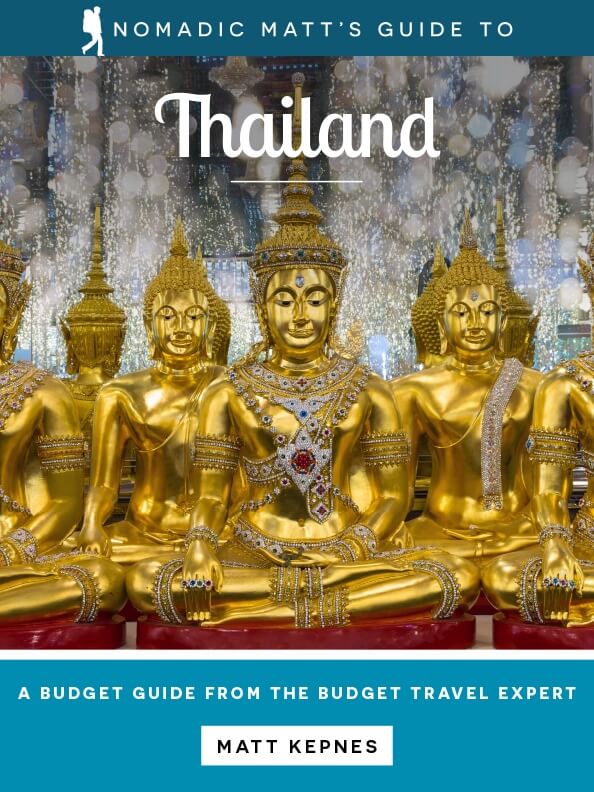
My detailed 350+ page guidebook is made for budget travelers like you! It cuts out the fluff found in other guidebooks and gets straight to the practical information you need to travel around Thailand. You’ll find suggested itineraries, budgets, ways to save money, on and off-the-beaten-path things to see and do, non-touristy restaurants, markets, bars, safety tips, and much more! Click here to learn more and get your copy today.
Bangkok Travel Guide: Related Articles
Want more tips for your trip? Check out all the articles I’ve written on Thailand travel and continue planning your trip:
